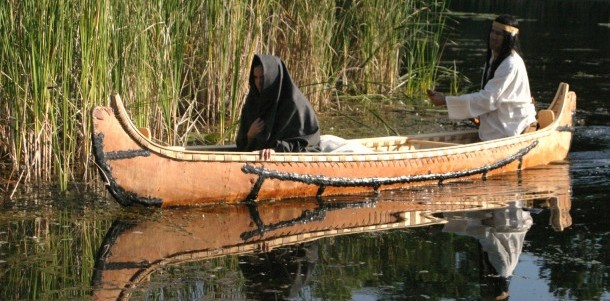

Saint Kateri
Gillian Kantor
Wednesday, October 17, 2012

Lisa Charleyboy and John Copegog during the filming of reenactments for In Her Footsteps.
by Gillian Kantor
“Catherine Tekakwitha is the name of the sainted young woman, who I am going to write about. She is today so renowned in New France because of the extraordinary marvels that God has performed and continues to perform everywhere through her intercession.” – Fr. Pierre Cholenec, SJWhen Fr. Pierre Cholenec penned these words, he was hopeful. His own life, his faith, his work as a missionary in the New World, had been changed by a quiet Native woman who prayed fervently in the woods. And now he wanted the world to know that Kateri Tekakwitha was indeed a saint. Born as, simply, Tekakwitha to a baptized Algonquin woman and a Mohawk Chieftain in 1656 along the Mohawk River, the young woman travelled a long spiritual journey. She battled near-fatal illness, cultural expectations, animosity from tribe members, and the forces of nature to live out her faith the way in which she believed God was calling her. The result of each brave footstep is, today, a worldwide following of faithful who call Kateri friend, sister, and healer. And over 300 years later, Cholenec’s hope has come true as the Church witnessed the canonization of St. Kateri Tekakwitha on October 21. Her story begins in what is now New York state, where Tekakwitha was born into the Mohawk tribe of the Iroquois Nation. When she was just six years old, small pox ravaged her village, claiming the lives of her mother, father, and brother. And although she, too, suffered from the fevers, aching bones, and painful blisters of the deadly disease, Tekakwitha lived – though her face left scarred and her eyes and health weak. Tekakwitha was taken in by an uncle and the close-knit women of the matriarchal society and, despite her infirmities, she fully participated in the duties of the traditional Iroquois longhouse, carrying wood, fueling fires, grinding corn, fetching water, sewing, and crafting intricate beadwork. As Tekakwitha and the Mohawk people carried out their traditional roles, a new world was developing around them. European settlers were looking for territory to claim and, with them, came Catholic missionaries seeking souls to claim. Jesuit missionaries lived and worked among Tekakwitha’s people, teaching the faith and baptizing those who expressed an interest in the Church. For years, Tekakwitha’s interaction with the missionaries remained limited until, one day, suffering from injury and unable to go into the fields, she met the young Fr. Jacques de Lamberville. Though a language barrier stood between them, Tekakwitha devoured the words and actions of the faith and, with his teaching and assistance, was baptized on Easter Sunday, 1676. She took the name Catherine, after St. Catherine of Sienna, and fully embraced and emulated the life of the 14th century mystic, who was persecuted by her own people and punished her own flesh out of her love for God.
“In less than a few months she became to her companions a model of humility, devotion, sweetness, charity, and all of the other Christian virtues…. Her extraordinary virtue brought upon her the persecutions even from those who once admired her.” - CholenecLiving as a devout Catholic among an Indian tribe was not easy. After she was baptized, it was hard for Kateri to stay in her village. Her uncle was mad and her tribe taunted her and accused her of being lazy when she wouldn’t work on Sundays. With Fr. de Lamberville’s urging, she moved to Kahnawake, a Christian Iroquois village on the banks of the St. Lawrence River. There was a woman named Anastasia who was a friend of her mother’s and acted like a godmother to Kateri. Anastasia tested her and taught her the faith. She also met two Jesuit missionaries working at Kahnawake – Fr. Pierre Cholenec and Fr. Claude Chauchetiere. They read the letter from Fr. de Lamberville that Kateri brought with her. It said, “You will soon know the treasure that we have given you. Guard it well then!” In Kahnawake, Kateri was better able to live out her faith life. She surrounded herself with a group of women who embraced the Church and desired to grow closer to God. It was with these women that Kateri first practiced ascetism. She and a friend would whip each other with willow branches, tearing their flesh in devotion to God. Alone, she would expose her bare skin to the bitter cold of the winter ice and snow, and place burning coals between her toes. She slept on a bed of thorny branches and sought Jesus in her sacrifice. Her devout faith impressed Frs. Cholenec and Chauchetiere, and Kateri received her first Communion on Christmas Day, 1677. Her first taste of the Eucharist made her hunger for God even more – she wanted to be his bride. But even in Kahnawake, a life of religious devotion wasn’t encouraged. In the longhouse society, women were expected to marry. Without a husband, how could Kateri bring food to the family’s pot, or provide the hides and moose hair she needed for her handiwork, or contribute pelts to the trade? She would become a burden on her family. But even though the matriarchs insisted she marry, Kateri refused. She was committed to celibacy and loving Christ alone. Kateri was never a healthy woman. Her smallpox had left her weak and, when she caught cold in the winter of 1680, it would prove too much for her. For two months she lay sick. As Holy Week approached, the sickness grew worse and the missionaries and her friends kept bedside vigil. They held her hands and prayed for her, but Kateri was not afraid. She spoke words of encouragement to them as they gathered. This was her heart’s desire, her soul’s longing, to be face to face with her Saviour. On Holy Thursday, April 17, Kateri succumbed to her illness. “I love you, Jesus.” These words left her lips and she died as if she were falling asleep.
“Then her face suddenly changed. It appeared to be smiling and devout and everyone was extremely astonished. We were all admiring her face, and we could not have tired ourselves of looking at her.” - CholenecFrom that miraculous change came others. Right from the time of her death, Kateri has been attributed as the healing grace to save many from sickness, near death, and dire situations. After 300 years of collected stories and healings, Pope John Paul II beatified Kateri in 1980 based on, not one proven miracle, but a reputation of healings and answered prayers. The cause for her sainthood now relied on just one miracle as a result of her intercession, and that miracle would come in the life of a little boy. In 2006, in Ferndale, Washington, five-year-old Jake Finkbonner contracted a vicious flesh-eating bacterium as a result of falling into the bleachers while playing basketball. The bacteria that entered a cut on his lip quickly spread through his face and, as doctors performed surgery after surgery to remove pieces of his skin, they told parents Elsa and Donny Finkbonner to pray. Pray, they did, offering their son to Kateri’s protection at the advice of their then-parish priest. Where medical hope was lost, Kateri persevered and after three weeks of rapidly deteriorating health, the disease suddenly disappeared. Jake was healed. The Vatican would examine the case and, with six years of study, interviews, and research, confirm Kateri’s hand in saving Jake’s life. With all of this within her – a life of persecution, illness, devotion, and courage – Kateri’s sufferings, sacrifice, and grace resonate with many people. Most particularly, she stands as a source of hope for Native American people who see her canonization as both an apology from and a welcoming into the Church after a history of persecution and alienation. Finally, the Church is holding up a Saint who represents the lifestyle, spirituality, and strengths of the Native American people and, as Cholenec wrote so many years ago:
“Among the miracles seen as having been rendered through Catherine Tekakwitha, I consider the greatest of them all to be Catherine Tekakwitha herself, as she is truly the Wonder Worker of the New World.”Join us in celebrating Saint Kateri's canonization. The Canonization Mass will air live on Sunday October 21 at 3:30am ET, 1:30am PT. It will repeat at 10:00am ET, 8:00am PT and 9:00pm ET, 6:00pm PT. The new S+L documentary, In Her Footsteps: The Story of Kateri Tekakwitha will make its World Television Premiere at that same day at 8:00pm ET, 9:00pm PT only on Salt + Light.
Related Articles:
<<













